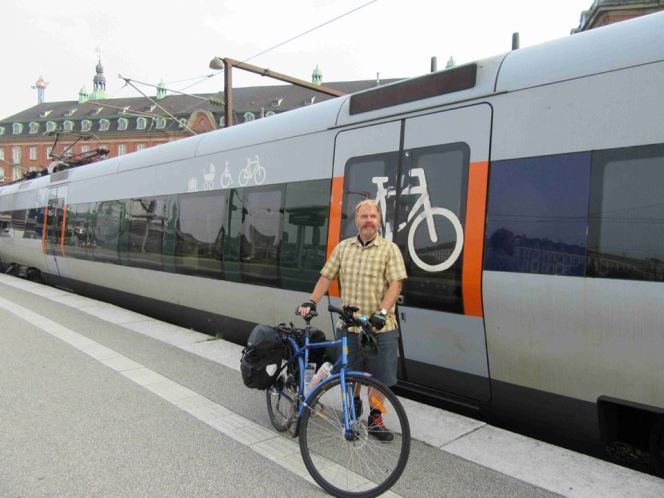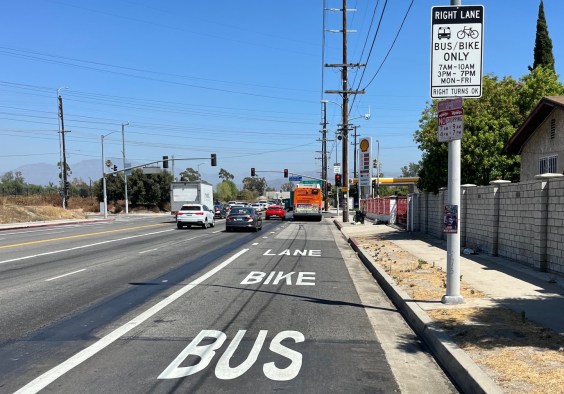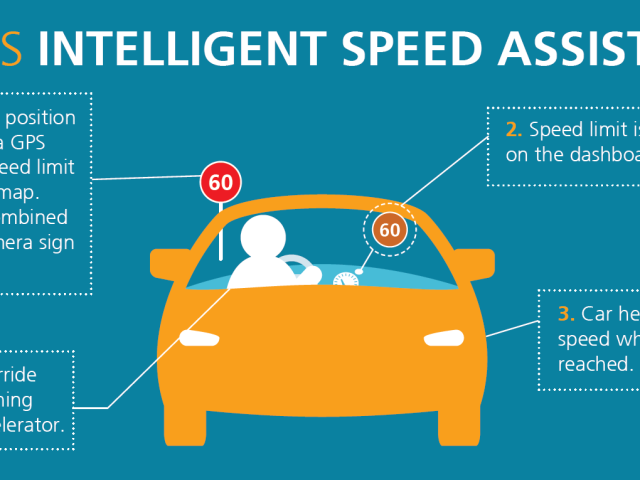Jason Henderson is a geography professor at San Francisco State, writer of the book Street Fight: The Struggle over Urban Mobility in San Francisco, co-author of Low Car(Bon) Communities: Inspiring Car-Free and Car-Lite Urban Futures, and a Streetsblog contributor.
Henderson recently returned from a sabbatical in Denmark, where he studied the intersection of bicycle infrastructure, housing, urban planning and politics in Copenhagen. Streetsblog caught up with him at his Hayes Valley home to talk about his study tour and discuss what he learned in Denmark and how it might apply to San Francisco.
**
Streetsblog: You were gone for a while.
Jason Henderson: I was away for five months. It was a research sabbatical; an opportunity to not just superficially visit Copenhagen—that iconic bicycle city—but truly experience it. I got to experience the seasonal changes, the everyday life, and to live in an apartment in the center of the city. In other words, regular everyday normal life in Copenhagen.
SB: But you did more than live there. Lots of learning and networking?
JH: The first thing I did was go to a Danish bicycle summit. A friend of mine translated it for me. There I met somebody who was involved with the cycle super highways, and then she had coffee with me and said you should talk to this person, or that person. I also reached out to professors in Copenhagen that have been writing about biking and transit.
SB: So you were prepping long before you got there?
JH: Before I went, I reached out to peers. I did a lot of reading in preparation.
SB: Any problems with the language?
JH: No. Lots of Danish articles are in English because if the Danes want to talk to anyone else, well, they have to talk in English. So I read, for example, “The Urban Turn," which is about the standard economic geography of Copenhagen—that gave good background. My aim was to learn about the politics of the bicycle against the broader politics of transport and city planning in Copenhagen. As a geographer, you want to understand the interconnections between threads of society.
SB: Give an example of what you mean.
JH: If you look at the bus in Copenhagen it's more multi-ethnic than the bikes. That stands out because Denmark is generally such a white country. There's a racial undertone to mobility even in Denmark.
SB: Really?
JH: It's not a big issue in the press. So as with the Mission 14 bus in San Francisco, there are certain neighborhoods in Copenhagen that are more diverse and that's reflected on the bus.
SB: Got it. So there's a ethnic overlay to transportation choices, just like here.
JH: Yes. I know that it's been an issue in Amsterdam, particularly with mopeds... some immigrants will come in and they prefer mopeds because motorization is seen as success—and pedaling is seen as failure.
SB: Denmark is known as a place with a strong social safety net and labor laws. That also intersects with transport?
JH: Yes. For example, mothers get lots of maternity leave, so you see cargo bikes and the babies all around Copenhagen. Childcare is something you see attended to all over the city.
SB: So the whole idea of making streets safe for even small children, throughout the urban center, is a reflection of general politics?
JH. Right. They focus on keeping children in the city; it's saying the city is for everyone, not just 22- to 25-year-old tech workers. Take housing. The emphasis in Copenhagen is not to build smaller apartments. It's to build bigger apartments, so people can keep their kids in the city. The prices are still high, but when you have a housing market that keeps people in the city, then you have families bringing children to school in cargo bikes, then when children get older they cycle too.
SB: So social policies that make it easier to raise children in the city help expand the bike culture? What does that look like in the streets? Copenhagen is famous for masses of cyclists of all types.
JH: It's beautiful. There are three different commutes. First is the early morning, when parents are bringing kids to schools. Then the parents, after they drop the kids off, they're blazing down Nørrebrogade—a big bike street—with empty child seats and cargo bikes, and you can see there was a little kid in there a minute before. At 3:30, it starts all over. There's this kid commute—you see little kids again, and then the real commute comes like an hour later, and now there's no more kids, but there are some interesting issues. There's more fear, about children getting hit by bikes.
SB: I see. So once kids are back from school and out playing they're afraid of them getting hit by faster adult bike commuters?
JH: Copenhagen is extremely well designed to encourage people to bike, but it's designed for about 20 percent bicycle mode share, and now it's more like 40 percent. And now their problem is it can take you five minutes to get through a bike-only intersection. They just have too many bikes and not enough capacity.
SB: But isn't that a great problem to have?
JH: Yes, but parents with little children used to let their kids bike. But now it's so crowded, and there are some cyclists who are faster, some are slower, some are more reckless... lots of people have kids and there's an expectation that the mobility system—bike, mode share, trains, the neighborhoods—should all work for children.
SB: So how do we get there in San Francisco?
JH: I think that if we in the U.S. are going to have an honest conversation about the urban future we have to understand political ideology. Because all ideologies have a spacial component. And in Denmark, the right wing is the one that's blocking Copenhagen from doing more for bikes.
SB: Like here. But I'd imagine it's all relative—meaning that their "conservatives" are more on par with our Democrats.
JH: They're like Mayor Ed Lee. For example, they caved on congestion pricing, like Ed Lee did on Sunday meters.
SB: So whether you support bicycle infrastructure is part of the whole political spectrum?
JH: The same folks who are threatening the universal healthcare system and education in Denmark are the same people who want to cut the car tax, want to build more roads—they're not helping the train system. In fact, they're critical of the train system and they've stymied it.... there's even a pro-business party in Denmark that wants to build a massive toll tunnel under Copenhagen.
SB: Gosh—even we have grown beyond that kind of thing, mostly.
JH: It will probably never get built, but it distracts them from thinking about transit. Denmark used to have a great train system. Now it's aging and kind of stuck, compared to Germany and Switzerland.
SB: It's funny to think though, San Francisco would be thrilled to have something on the level of Danish public transport, but, yes, relative to other European nations... I know they lag in rail electrification, compared to the rest of Europe.
JH: Yes. Lots of diesel, no high-speed rail. Electrification is stagnating because of the far right's resistance to investing in these kinds of things. But they want to build highways. But remember where they are and where we are. They have 36 percent of trips within Copenhagen done by bike, so they're starting there. So their challenge is getting to 50 percent. But the politics won't let them. Plus it's harder to take away car space in the city because they've already taken away so much [of it]. Now here we are in San Francisco at about three percent and we can't do sh*t. They're in a different place, but the ideological alignments are remarkably similar.
SB: Really?
JH: There are nuances. For example, there are some conservatives who support bike infrastructure because it's become part of Danish identity. The white nationalists talk about how biking is Danish.
SB: The far right is on the same page as the social democrats about bikes?
JH: Yeah, sometimes. The left talks about climate change. The conservatives are like, f*ck it, that's not our problem. But they both support bikes.
SB: And that's how they managed to push bike policies forward. I guess politics really do make strange bedfellows. What does that teach us in San Francisco?
JH: It's important for the sustainable transportation movement not to get bogged down in the cultural argument. The Danes didn't start riding bikes in the 1970s because of culture. They had to fight for it. Our left isn't that different from their left, and our right is not that different from their right. The challenges are political, not cultural. For Copenhagen, it took politics to do it... proposals to build freeways all through Copenhagen galvanized a movement against those highways. Bringing a bike-friendly reality to the built environment took a decade or two... there were fits and starts... but in the end, it was political leadership.
SB: Like Mayor Bloomberg in New York or Gregor Robertson in Vancouver? In other words, they got leaders who fought for safe streets. So aside from the political example, what could be brought over here and plopped onto the streets of San Francisco?
JH: Their cycle tracks work... every now and then you might have a delivery truck slightly on it, but they do a pretty good job of keeping cars off. But bikes also have complete connectivity of the bike infra, everywhere you go—you don't even really need a bike map. You're completely separated from cars and it is just liberating and calming. But you start to become just like a Dane, complaining about their infrastructure... after five months I was like f*ck this cycle track, it's too narrow....
SB: Meanwhile, it's still worlds better than anything we have.
JH: Oh yeah! Better than anything we have.
SB: What's it like for the motorists?
JH: You can't expect to drive across Copenhagen very easily. It's not an entitlement to drive. But there's this tacit agreement that because the bikes are on cycletracks it makes it easier to drive. You follow the rules, and even though you don't have six lanes to get across town, you only have one, it's slower, but it's more reliable. Reliability is more important than speed. There's just one big auto-road across town. It's not like our streets where we have Oak, Fell, Geary, Potrero, 19th—we have like twenty streets that are big and aimed at moving lots of cars.
SB: And that's not a reflection of our differing cultures?
JH: No. We have just as many people in California who are ready for 40 percent mode share by bike, and they have just as many people who want an SUV and want gated communities and want immigrants out. It's a difference of who has the power. And we've given the cars too much power.
SB: Any other thoughts?
JH: Just that I've got to go back.
This interview was edited.
A jet-lagged but well-caffeinated Henderson back in his San Francisco apartment, studying a map of Copenhagen. Photo: Streetsblog






